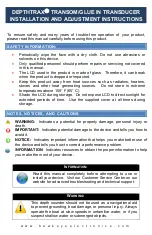
w w w . h a w k e y e e l e c t r o n i c s . c o m
of the boat over the base of the transducer. The water should be "Clean"
with very little turbulence (air bubbles). If there are any air bubbles or
turbulence seen passing underneath the transducer, move the transducer
farther down on the transom bracket. If the performance does not
improve, move the transducer to "Clean Water" making sure to fill any
unused screw holes with marine sealant.
N
OTICE
High Speed performance of the depth sounder may require
extensive adjustment and testing to find the best transducer
mounting location. This transducer has been tested to perform
up to 63 MPH in an In-Hull application. Not all boat hull
configurations will allow for this type of performance. If you are not
satisfied with the performance of the depth sounder, it is recommended
that you seek the advice of a professional marine electronics installer.
GLUING THE TR ANSDUCER IN-HULL
N
OTICE
:
Please use extreme caution when selecting your
adhesive as the overall performance and enjoyment
of your depth sounder depends heavily on the type of
adhesive you use.
USE ONLY A 2-PART, SLOW CURE
EPOXY
Tools and Supplies Required
•
Plastic Bag
•
Petroleum Jelly
•
30 Grit Sandpaper
•
2 Part Epoxy Adhesive
•
Tie Wraps
Vessel Hull Types Acceptable for In-Hull Installation
•
High speed boats to increase the performance of the depth sounder.
•
Trailer boats to prevent accidental damage to the transducer from
trailering.
•
Shallow draft boats to prevent accidental damage to the transducer from
intentional or unintentional ground.
•
NON-CORED
hulls or aluminum hulls thinner than 1/8”.
•
Inboard vessels that have a lot of running gear that creates significant
turbulence.




















